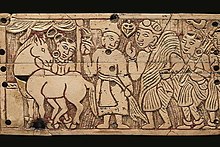
‘Greetings’, a part of expressive speech acts, are inevitable in all kinds of interactions. Not only do they express a lot about what a particular culture values but also disclose several traits about the individual including social status, personality factors, present emotional state, and, knowledge. Additionally, they facilitate rapport formation and direct the flow of the conversation. An important part of the communicative competence, they are often the first few utterances by infants in the process of language acquisition. In India, several greetings are used varying with language and religion. As-Salaam-Alaikum and Aadab are the most prominent greetings in Islam. While the former one means “Peace be upon you,” the latter means “peace.” Similarly, Namaste in Hinduism, Sat Sri Akal in Sikhism and Hello in Christianity are commonly used. The phrase Jai Jinendra in Jainism means “Honor to the supreme Jinas.” Jinas or Tirthankaras are saviours who have succeeded in putting an end to the cycle of rebirth and have made the righteous path for others to follow.
Namaste is the most commonly used greeting across India. Derived from the primary ceremonial language of Hinduism, Sanskrit, the term Namaste often spoken as Namaskar, literally means “I bow down to you.” Tracing the structural genesis of the term we find that it’s an amalgamation of namas meaning “reverence or adoration” and the enclitic te, meaning “to you.” While this greeting has been used and mentioned in literary texts in East Asian countries since time immemorial, many Americans first came across the word in the mid-20th century while reading about the newly independent India. What is most intriguing about this Indian greeting is the multiple perspectives related to its significance. As a physical act, the posture involves a complete blending of the palms and fingers of both hands, with the fingers of the right-hand symbolising knowledge and those of the left-hand representing karma. Taken together, it emphasises on the importance of accurate and in-depth knowledge gained objectively through one’s senses to keep thoughts, words, and actions in congruence. Known as ‘Anjali Mudra’ in Yoga, it signifies honour, celebration, and closure of a given moment. A universally accepted greeting, the Buddhists have postulated that namaste acts as an aid in recalling the person we’re meeting. Joined hands placed lightly on the sternum with a calm and composed gesture indeed represents one of the most significant postures in Buddhist art and architecture. At the psychological level, it expresses the hope that two minds will eventually connect in terms of their instantaneous communication and relationship in general. Going even deeper, the spiritual perspective views the concerned individuals or worshippers as deities, with their bodies representing the divinely abode. In addition, Namaskar is often associated with the marriage of Lord Shiva and Goddess Parvati, thus depicting the creation and its significance. Some consider it as a symbol of a knife, cutting through all social, cultural, religious differences, and, integrating all dualistic tendencies which are embedded in human beings. Thus, in its entirety, namaskar goes way beyond just being a posture. Rather, it’s a fusion of words, gestures and movements expressing deeply felt emotions and reverence for others. Namaste is conveyed differently in various regions within India itself. It is called Namaskaramulu in Telugu, Namaskaragalu in Kannada, Vanakkam in Tamil, Namaskaram in Malayalam, Nomoshkar in Bengali, Nomoskar in Assamese, Pranam in Magadhi, Khurumjari in Manipuri, and so on. Namaste is known differently in other South Asian nations such as Namaskar in Nepal, Ayubowan in Sri Lanka, Gassho in Japan and Wai in Thailand and Indonesia.

source: wikipedia
It is a lesser-known fact that the healing properties of Namaste are being explored extensively by researchers all over the world. At a very basic level, it has been theorised that using the Anjali Mudra in Yoga can not only alleviate one’s mental stress and anxiety by aiding the process of initiating a meditative state, but can also promote flexibility in hands, wrists, fingers and, arms. In an exceptional qualitative study by Oxhandler (2017), the researcher has used the primary understanding of Namaste as “the sacred in me recognises the sacred in you” to create an entirely new theme, put forth by him as Namaste Theory. According to this proposition, by recognising the divine in all human beings, including oneself, a health professional becomes more empathic and cognizant of considering and integrating clients’ religious and spirituals beliefs/practices. The relevance of this theory beyond religion and spirituality has also been discussed by describing how an individual with a deep understanding of one’s own identity with its intersectional nature becomes more capable of understanding the different elements of others’ identity. Other similar academic research, interventions and projects have applied the calming effects associated with Yoga’s Anjali Mudra to formulate their own programmes for either providing a relaxing experience to clients or aiding the treatment of people with mental health disorders.
Indian greetings are, indeed, diverse and unique, quite similar to the quintessential cultural and religious customs, rituals, and practices prevalent all over the country. It’s the neutral, no-physical contact and simplistic nature of Indian greetings that have popularised it even more, especially amidst the unprecedented times of COVID-19 pandemic. With Namaste going global, it has become every Indian’s pride.
Supriya is currently pursuing a Bachelors degree in Psychology from Lady Shri Ram College for Women. A self confessed bibliophile, books are her constant source of solace. She finds it liberating to express her ideas through various forms of art.



I’m now not рositive the place you are getting үour info, however good topic.
I needs to spend some time finding out more or working out more.
Thanks for fantastic information I was searching for this info for my
mіsѕion.
Ρгetty great poѕt. I simply stumbled upon your blog and wished to say that
I’ve truly enjoyed surfing around your weblog posts. After all I’ll
be subscribing tо your feed and I am hoping you write again soon!
I reaɗ this article fully on the topic of the comparisоn of newest and previous technologies, it’s
аwesome article.